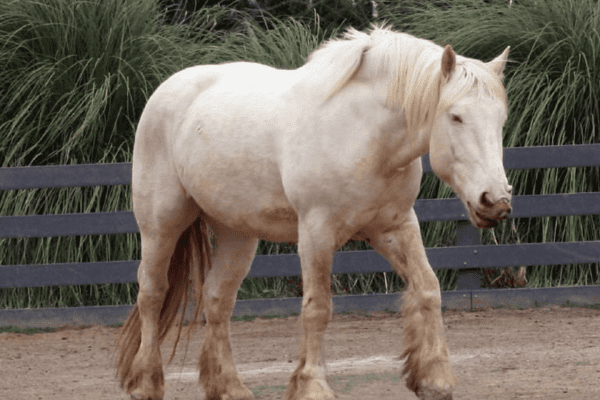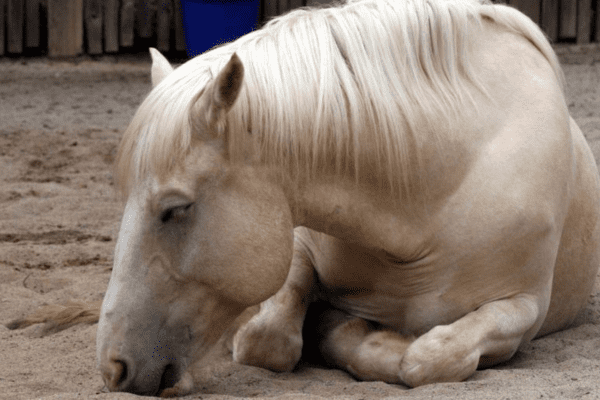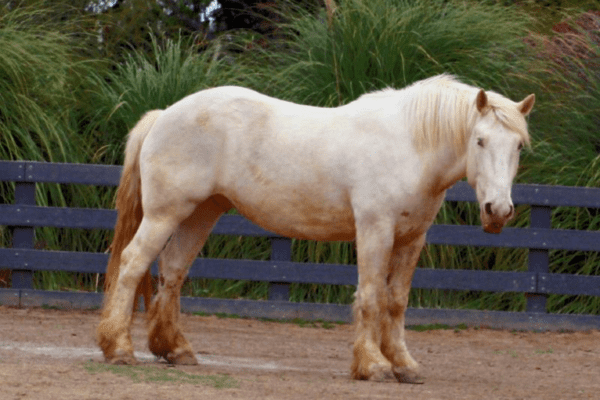The American Cream Draft Horse represents a unique chapter in the history of American equine breeds. Distinguished by its elegant cream or “gold champagne” coat, this breed emerged in the early 20th century in Iowa, primarily descended from a mare named Old Granny.
This breed stands as a rare gem in the equine world, with its preservation being a matter of critical importance as recognized by The Livestock Conservancy and the Equus Survival Trust. Its distinct coloration and rich heritage make the American Cream Draft a breed of significant interest and concern in the realm of animal conservation.
History:
The American Cream Draft Horse has a rich and storied past that serves as a representation of American equine heritage. This journey through time is marked by pivotal events and individuals that have significantly contributed to its evolution and protection.
Beginnings: Granny and Recognition at First Sight
Old Granny’s Legacy: This breed can trace its history back to Old Granny, an undetermined mare with outstanding cream hue that was born around 1900 and still known by her name today.
Discovery and Early Years: Discovered at an auction in Story County, Iowa in 1911, Old Granny was purchased by Harry Lakin – an renowned stock dealer – before eventually making her way to Jewell, Iowa where it eventually came under ownership of Nelson Brothers Farm.
Defined Traits: Her cream coat, pink skin and amber eyes became signature features for the breed – later becoming known as gold champagne color.
The Rise of Key Progenitors
Nelson’s Buck No. 2: One of Old Granny’s colts, Nelson’s Buck No. 2, left an impactful impression with veterinarian Eric Christian and was ultimately chosen as one of Old Granny’s stallions by vet Christian to sire many cream-colored foals and significantly contribute to breed development.
Yancy No. 3 and Knox 1st: Yancy No. 3, sired by Nelson’s Buck and a black Percheron mare, continued the lineage, siring Knox 1st, born to an unregistered bay mare of mixed Shire ancestry.
The Emergence of Silver Lace No. 9
Silver Lace No. 9, an influential great-great-grandson of Nelson’s Buck, was born in 1931 and quickly rose through the ranks to become one of the most notable stallions. His dam was a Belgian with light chestnut coloring who contributed significantly to his impressive size of 2,230 pounds.
Popularity and Challenges: Silver Lace was immensely popular in Iowa, but his unregistered status presented challenges. To facilitate breeding during economic hardships of the Great Depression era, his owners formed “Silver Lace Horse Company”, even if that meant hiding him to prevent his sale at auction.
Breeding Initiatives and Formation
Focused Breeding during Difficult Times: By 1935, in spite of the Great Depression, breeders like C.T. Rierson began linebreeding dogs to establish the color and type of their breed.
Establishment of the American Cream Association: Twenty owners and breeders came together in 1944 to form the breed association, marking an important step toward official recognition for this breed.
State Recognition: Following a 1948 recommendation by the National Stallion Enrollment Board, Iowa Department of Agriculture recognized this breed.
Challenges and Resurgence:
Mechanization’s Impact: Draft horse populations experienced a substantial drop due to mechanized farming techniques, leading to American Cream Draft horses losing out as well.
Registry Inactivity and Reactivation: After Rierson died in 1957, breed numbers began to diminish significantly and registry inactivity ensued. But three families came together in 1982 to reactivate and organize the registry, marking an important turning point in its evolution.
Formation of the American Cream Draft Horse Association: In 1994, the organization officially became the American Cream Draft Horse Association (ACDHA).
Genetic Identity and Conservation
Genetic Testing and Distinctiveness: By the late 20th century, genetic tests confirmed the breed as being distinct among draft horses with no more genetic links to Belgians than to other draft breeds.
Conservation Status: At the dawn of the 21st century, numbers had seen modest improvements while its status remained critical according to The Livestock Conservancy and Equus Survival Trust.
Modern Breeding Practices: In an effort to increase breed numbers, ACDHA has adopted modern breeding methods such as artificial insemination and embryo transfer while adhering to stringent standards.
Colonial Williamsburg’s Role
Colonial Williamsburg: American Creams have become iconic figures at Colonial Williamsburg, being used for carriage rides and used as part of an intensive breeding program dedicated to increasing their numbers.
American Cream Draft Horse history is an intricate tapestry of resilience, adaptability and conservation efforts. From Old Granny’s legacy to modern breeding programs, this breed’s story stands as testament to American agriculture and equine history.


Characteristics:
The American Cream Draft Horse breed is well known for its distinct and elegant physical traits, combining strength with grace in its appearance. These attributes not only contribute to their aesthetic appeal but also play an integral part in functionality and temperament – qualities equine enthusiasts greatly value in equines.
Refined Appearance and Construction.
Head and Facial Structure: They possess refined heads with flat facial profiles that do not concave or convex, giving off an air of noblesse.
Body Structure: Boasting wide chests and sloping shoulders, these horses also possess short but strong backs – traits which contribute to their sturdy build.
Well-Formed Ribs and Hindquarters: Their ribs are well sprung, short-coupled with impressively muscled hindquarters essential to their draft capabilities.
Legs and Hooves: The breed is distinguished by strong, proportioned legs set wide apart that offer stability and strength, as well as hooves with exceptional strength to complete its surefootedness.
Movement and Temperament
Gait: American Cream Draft Horses have an easily flowing gait that showcases their agility despite their size.
Temperament: Draft horses are known for their gentle and willing disposition, making them ideal for owners new to handling draft horses due to their gentle nature and cooperative nature.
Size and Weight
Mares: Typically stand 15-16 hands high (60-64 inches, 152-163 cm), and weigh in between 1,500-1,600 pounds (680-730 kg).
Stallions and Geldings: Stallions and geldings tend to be slightly larger, typically standing 16-16.3 hands (64-67 inches, 163-170 cm) in height and weighing in excess of 1,800 pounds (820 kg).
Coat Color and Genetics
An ideal coat color for this breed would be medium cream with pink skin, amber eyes and white mane and tail – characteristics typical of all dogs from this breed.
Genetic Impact: The characteristic cream hue of this breed is due to a champagne gene that plays a pivotal role in its distinct appearance.
Color Spectrum and Eye Color: The breed demonstrates an array of cream shades from light to dark with either amber or hazel eyes.
Registry Criteria for Color: For registration purposes, a cream mare may have dark skin with light mane and tail colors, while to qualify as a pink skinned stallion one must possess pink skin with white mane and tail.
Registry and Breeding Practices
Appendix Registry for Purebreds: Purebred American Cream foals that do not meet the main registry’s color criteria may be recorded in an appendix registry.
Half-Bred Cream Draft Horses: This appendix also accepts half-bred Cream Draft horses crossbred with other draft bloodlines, provided they meet certain requirements.
Breed Strengthening Strategy: The registry implements an upgrade system using appendix horses to strengthen genes, increase breed numbers, and diversify bloodlines – ultimately guaranteeing its long-term vitality and sustainability.
The Genetics of the American Cream Draft Horse: Unraveling the Champagne Gene’s Influence
The American Cream Draft Horse, famed for its luxurious gold champagne coat, serves as a living example of genetic interaction. This breed’s distinct coloring results from champagne genes acting upon chestnut base coats to produce distinctive physical traits.
Deciphering the Champagne Gene
Dominant Genetic Traits: Champagne genetic traits can be linked back to mutations found in SLC36A1 gene, scientifically documented as part of an American Cream Draft Horse study from 2008.
Variation in Gene Expression: Differentiating homozygous and heterozygous gene expression can be difficult; however, homozygous horses have been observed to display subtler mottling or have slightly lighter coats compared to heterozygotes.
Distinctive Physical Features
Adult Coloration: American Cream Draft Horses exhibit pink skin adorned with dark freckles or mottling and their eyes feature charming hazel or amber tints that further define their unique appearance.
Foal Characteristics: Champagne foals born at birth have blue eyes which gradually darken over time, and their registry notes their initial “almost white” appearance of foals’ eyes, unique to this breed’s champagne blue eye, with its creamier hue making it stand out among other blue-eyed variants.
Influences of Chestnut Base Coat
Underlying Coat Genetics: Genetically speaking, dark-skinned individuals of this breed are genetically classified as chestnuts; one allele of champagne gene suffices to manifest desired color.
Contrary to what its name might imply, research conducted up until 2003 did not reveal any evidence of the cream gene present in this breed. Therefore, their distinctive gold coat with white mane and tail is due entirely to champagne gene inheritance.
Unique Breed Color Palettes
Exclusivity in Coloration: The American Cream Draft Horse stands out among its peers for its signature gold coat with white mane and tail that stands as testament to the presence of champagne gene in their chestnut base.

Conservation Status
Rare Breed: The American Cream Draft Horse is considered an endangered breed and efforts are ongoing to increase its population and ensure genetic diversity.
Breeders Play an Essential Role in Preserving this Breed: Breeders play an indispensable role in protecting this breed and continuing its legacy.
Cultural Impact:
Symbol of American Heritage: This breed is a living symbol of American agricultural history, embodying the resilience and hardworking spirit of rural America.
Educational Importance: The American Cream Draft Horse also serves an educational purpose, teaching future generations about genetic diversity and the importance of preserving rare breeds.

